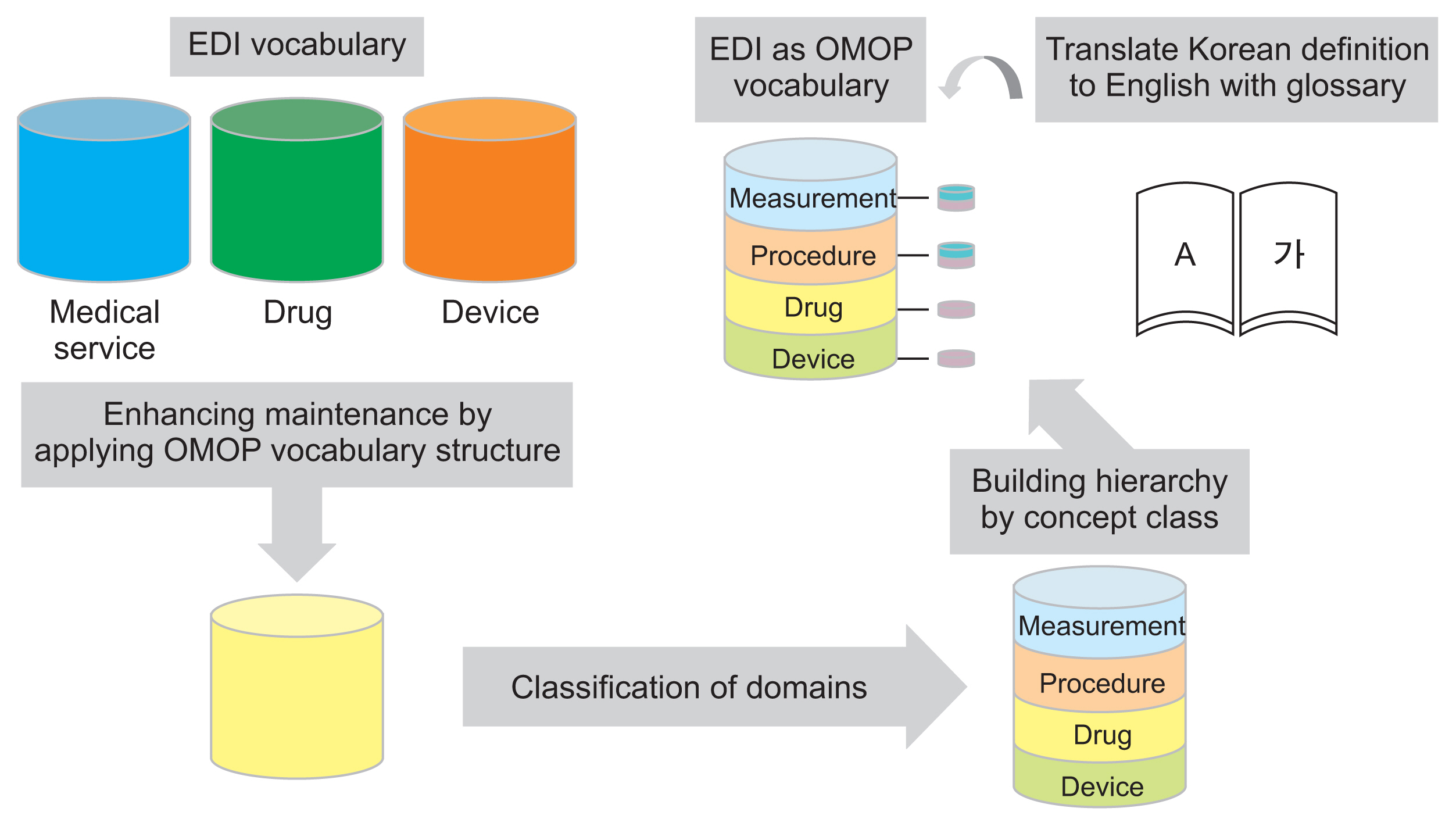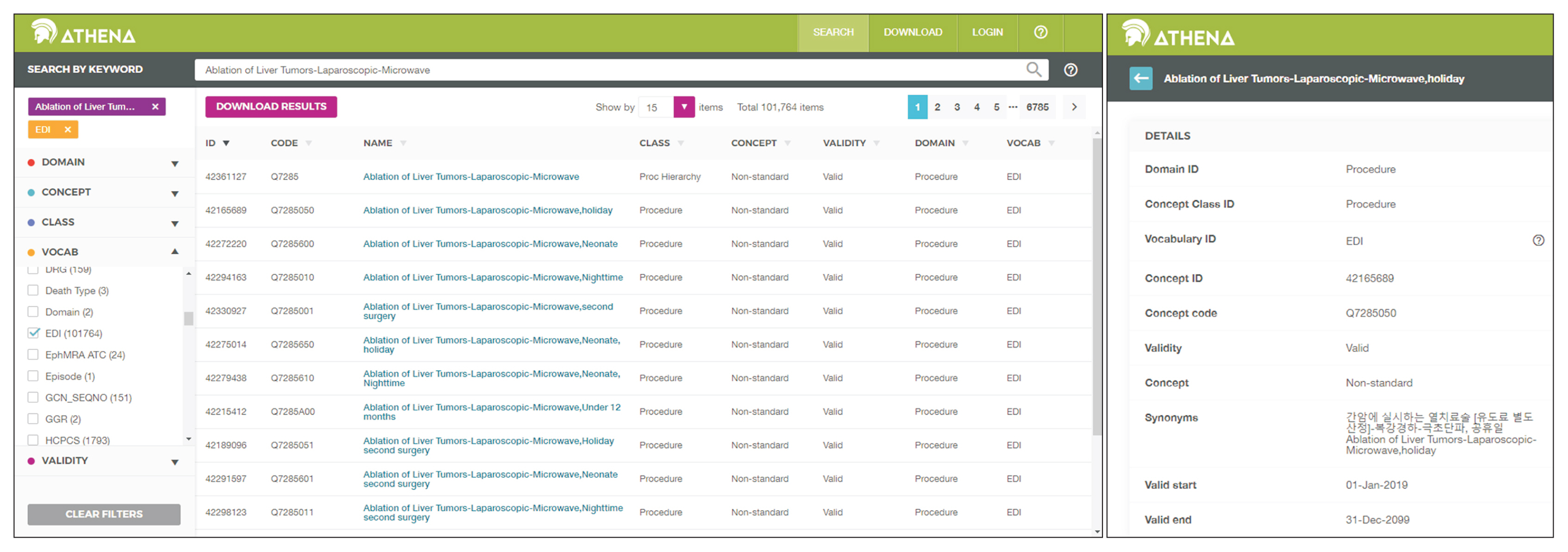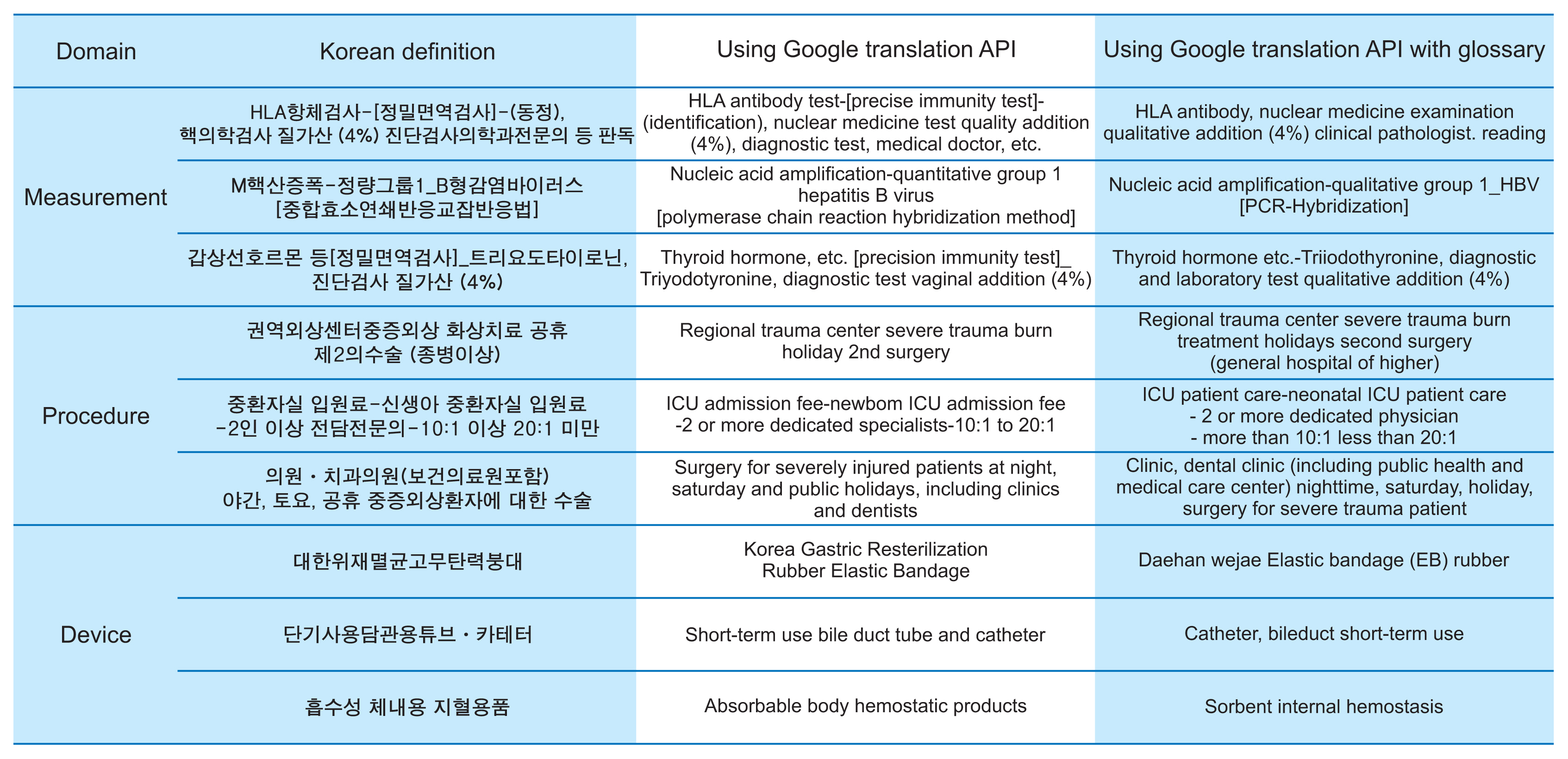Healthc Inform Res.
2021 Jan;27(1):29-38. 10.4258/hir.2021.27.1.29.
Incorporation of Korean Electronic Data Interchange Vocabulary into Observational Medical Outcomes Partnership Vocabulary
- Affiliations
-
- 1Department of Biomedical Informatics, Ajou University School of Medicine, Suwon, Korea
- 2Department of Sociology, Yonsei University, Seoul, Korea
- 3Department of Biomedical Informatics, Columbia University, New York, NY, USA
- 4Health Insurance Review & Assessment Service, Wonju, Korea
- 5Deparment of Biomedical Sciences, Ajou University Graduate School of Medicine, Suwon, Korea
- 6Odysseus Data Services Inc., Cambridge, MA, USA
- 7Real Wolrd Solutions, IQVIA, Cambridge, MA, USA
- 8Department of Medical Humanities and Social Medicine, Ajou University School of Medicine, Suwon, Korea
- KMID: 2512622
- DOI: http://doi.org/10.4258/hir.2021.27.1.29
Abstract
Objectives
We incorporated the Korean Electronic Data Interchange (EDI) vocabulary into Observational Medical Outcomes Partnership (OMOP) vocabulary using a semi-automated process. The goal of this study was to improve the Korean EDI as a standard medical ontology in Korea.
Methods
We incorporated the EDI vocabulary into OMOP vocabulary through four main steps. First, we improved the current classification of EDI domains and separated medical services into procedures and measurements. Second, each EDI concept was assigned a unique identifier and validity dates. Third, we built a vertical hierarchy between EDI concepts, fully describing child concepts through relationships and attributes and linking them to parent terms. Finally, we added an English definition for each EDI concept. We translated the Korean definitions of EDI concepts using Google.Cloud.Translation.V3, using a client library and manual translation. We evaluated the EDI using 11 auditing criteria for controlled vocabularies.
Results
We incorporated 313,431 concepts from the EDI to the OMOP Standardized Vocabularies. For 10 of the 11 auditing criteria, EDI showed a better quality index within the OMOP vocabulary than in the original EDI vocabulary.
Conclusions
The incorporation of the EDI vocabulary into the OMOP Standardized Vocabularies allows better standardization to facilitate network research. Our research provides a promising model for mapping Korean medical information into a global standard terminology system, although a comprehensive mapping of official vocabulary remains to be done in the future.
Figure
Cited by 1 articles
-
Common Data Model-based Analysis of Selective Leukoreduction Protocol Compliance at Three Hospitals
Sooin Choi, Soo Jeong Choi, Jeong Won Shin, Young Ahn Yoon
Ann Lab Med. 2023;43(2):187-195. doi: 10.3343/alm.2023.43.2.187.
Reference
-
References
1. Park HA, Kim HY, Min YH. Use of clinical terminology for semantic interoperability of electronic health records. J Korean Am Med Assoc. 2012; 55(8):720–8.
Article2. Healthcare Information Standard [Internet]. Seoul, Korea: Korea Health Information Service;2017. [cited at 2021 Jan 26]. Available from: https://www.hins.or.kr/cmm/main/mainPage.do.3. Kim M. A study on a comparison of diagnostic domain between SNOMED CT and Korea standard terminology of medicine. Int J Database Theory Appl. 2015; 9(11):49–60.
Article4. Jung BK, Kim J, Cho CH, Kim JY, Nam MH, Shin BK, et al. Report on the Project for Establishment of the Standardized Korean Laboratory Terminology Database, 2015. J Korean Med Sci. 2017; 32(4):695–9.
Article5. Hwang EJ, Park HA, Sohn SK, Lee HB, Choi HK, Ha S, et al. Mapping Korean EDI medical procedure code to SNOMED CT. Stud Health Technol Inform. 2019; 264:178–82.6. Hripcsak G, Duke JD, Shah NH, Reich CG, Huser V, Schuemie MJ, et al. Observational Health Data Sciences and Informatics (OHDSI): opportunities for observational researchers. Stud Health Technol Inform. 2015; 216:574–8.7. Garza M, Del Fiol G, Tenenbaum J, Walden A, Zozus MN. Evaluating common data models for use with a longitudinal community registry. J Biomed Inform. 2016; 64:333–41.
Article8. Cimino JJ. Desiderata for controlled medical vocabularies in the twenty-first century. Methods Inf Med. 1998; 37(4–5):394–403.
Article9. EdiToOmop: the package to convert Korean EDI code to the OMOP vocabulary [Internet]. San Francisco (CA): GitHub Inc;2020. [cited at 2021 Jan 26]. Available from: https://github.com/OHDSI/EdiToOmop.10. Chute CG, Cohn SP, Campbell JR. A framework for comprehensive health terminology systems in the United States: development guidelines, criteria for selection, and public policy implications. ANSI Healthcare Informatics Standards Board Vocabulary Working Group and the Computer-Based Patient Records Institute Working Group on Codes and Structures. J Am Med Inform Assoc. 1998; 5(6):503–10.11. Rosenbloom ST, Miller RA, Johnson KB, Elkin PL, Brown SH. Interface terminologies: facilitating direct entry of clinical data into electronic health record systems. J Am Med Inform Assoc. 2006; 13(3):277–88.
Article12. Lee KC. A study on enhancing terminology & its major issues [dissertation]. Seoul, Korea: Yonsei University;2012.13. ATHENA. OHDSI vocabularies repository [Internet]. Bethesda (MD): Observational Health Data Sciences and Informatics;2018. [cited at 2021 Jan 26]. Available from: http://athena.ohdsi.org.14. Han SH, Lee MH, Kim SG, Jeong JY, Lee BN, Choi MS, et al. Implementation of medical information exchange system based on EHR standard. Health Inform Res. 2010; 16(4):281–9.
Article15. Kim TG, Kwon O, Shin YS, Sung JH, Koh JS, Kim BT. Endovascular treatments performed collaboratively by the Society of Korean Endovascular Neurosurgeons members: a nationwide multicenter survey. J Korean Neurosurg Soc. 2019; 62(5):502–18.16. You SC, An MH, Yoon D, Ban GY, Yang PS, Yu HT, et al. Rate control and clinical outcomes in patients with atrial fibrillation and obstructive lung disease. Heart Rhythm. 2018; 15(12):1825–32.
Article17. Burn E, You SC, Sena AG, Kostka K, Abedtash H, Abrahao MT, et al. Deep phenotyping of 34,128 patients hospitalised with COVID-19 and a comparison with 81,596 influenza patients in America, Europe and Asia: an international network study. medRxiv. 2020. [Epub]. https://doi.org/10.1101/2020.04.22.20074336.
Article18. Korean OMOP Vocabulary [Internet]. San Francisco (CA): GitHub Inc;2019. [cited at 2021 Jan 26]. Available from: https://github.com/ohdsi-korea/OmopVocabularyKorea.19. OHDSI-Korea [Internet]. San Francisco (CA): GitHub Inc;2019. [cited at 2021 Jan 26]. Available from: https://github.com/ohdsi-korea.
- Full Text Links
- Actions
-
Cited
- CITED
-
- Close
- Share
- Similar articles
-
- The Development of Viewer of Electronic Medical Vocabulary based on MED: The Viewer of Electronic Medical Vocabulary
- Correction System of a Mis-recognized Medical Vocabulary of Speech-based Electronic Medical Record
- A Study for Building a System of Consumer Vocabulary for Health Information
- Fully connecting the Observational Health Data Science and Informatics (OHDSI) initiative with the world of linked open data
- A clinical research strategy using longitudinal observational data in the post-electronic health records era





